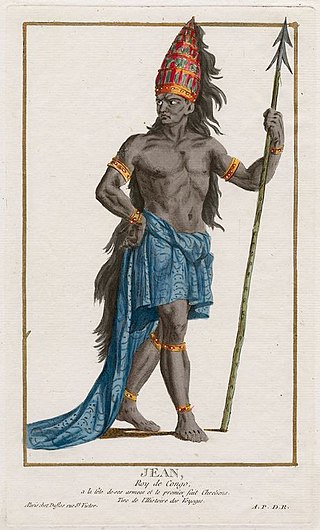
Álvaro I Nimi a Lukeni lua Mvemba was a Manikongo, or king of Kongo, from 1568 to 1587, and the founder of the Kwilu dynasty.

The Kingdom of Kongo was a kingdom in Central Africa. It was located in present-day northern Angola, the western portion of the Democratic Republic of the Congo, southern Gabon and the Republic of the Congo. At its greatest extent it reached from the Atlantic Ocean in the west to the Kwango River in the east, and from the Congo River in the north to the Kwanza River in the south. The kingdom consisted of several core provinces ruled by the Manikongo, the Portuguese version of the Kongo title Mwene Kongo, meaning "lord or ruler of the Kongo kingdom", but its sphere of influence extended to neighbouring kingdoms, such as Ngoyo, Kakongo, Loango, Ndongo, and Matamba, the latter two located in what is Angola today.

Garcia II Nkanga a Lukeni a Nzenze a Ntumba, also known as Garcia Afonso for short, ruled the Kingdom of Kongo from 23 January 1641 to 1661. He is sometimes considered Kongo's greatest king for his religious piety and his near expulsion of the Portuguese from Angola. Yet, he is also notorious for enriching himself through his leading role in the Atlantic slave trade.

The Kimpanzu were members of the Mpanzu kanda also known as the House of Kimpanzu, one of the lineages from which the kings of Kongo were chosen during the 17th century and following Kongo's reunification under Pedro IV. They are remembered in tradition and are evoked in a proverb, still current in the 1920s Nkutama a mvila za makanda "Kinlaza, Kimpanzu ye Kinlaza makukwa matatu malambila Kongo".

The Kinlaza were members of the Nlaza kanda or House of Kinlaza, one of the ruling houses of the Kingdom of Kongo during the 17th century. It was one of the main factions during the Kongo Civil War along with the Kimpanzu and Kinkanga a Mvika kandas. They are remembered in tradition and are evoked in a proverb, still current in the 1920s Nkutama a mvila za makanda "Kinkanga, Kimpanzu ye Kinlaza makukwa matatu malambila Kongo".

Lukeni lua Nimi was the traditional founder of the Lukeni kanda dynasty, first king of Kongo and founder of the Kingdom of Kongo Dia Ntotila. The name Nimi a Lukeni appeared in later oral traditions and some modern historians, notably Jean Cuvelier, popularized it. He conquered the kingdom of Mwene.

King João I was the 5th ManiKongo of the Kingdom of Kongo between 1470 and 1509. He voluntarily converted to Roman Catholicism. He was baptized on 3 May 1491 and took the Christian name of João. Soon after, ManiKongo Nzinga-a-Nkuwu João I abandoned the new faith for a number of reasons, one of them being the Roman Catholic Church's requirement of monogamy. Politically, he could not afford to abandon polygamy and embrace monogamy, a cultural shift that the king could not contemplate as power in Kongo was elective, rather than hereditary as in Europe; as Kongo culture followed a matrilineality structure, where the elder son of the king is not automatically the next king.

Pedro I Nkanga a Mvemba was manikongo of the Kingdom of Kongo from 1543 until being deposed in 1545.

Pedro II Nkanga a Mvika was a ruler of the kingdom of Kongo during the kingdom's first conflict with the Portuguese. He was the founder of the royal House of Nsundi and could trace his descent to one of Afonso I's daughters. He was succeeded by his son Garcia I, who was crowned in 1624.
The Kongo Civil War (1665–1709) was a war of succession between rival houses of the Kingdom of Kongo. The war waged throughout the middle of the 17th and 18th centuries pitting partisans of the House of Kinlaza against the House of Kimpanzu. Numerous other factions entered the fray claiming descent from one or both of the main parties such as the Água Rosada of Kibangu and the da Silva of Soyo. By the end of the war, Kongo's vaunted capital had been destroyed and many Bakongo were sold into the Trans-Atlantic Slave Trade.

The Kinkanga, usually known as the Kinkanga a Mvika or House of Nsundi, was a royal kanda formed by King Pedro II, which ruled the Kingdom of Kongo from 1622 to 1631. While King Pedro II and his son Garcia I were the only other member of the faction or kanda to rule, it retained powerful members in provincial offices in the 1650s until its destruction in the 1670s. Despite this loss in prominence, they were remembered in tradition and are evoked in a proverb, still current in the 1920s Nkutama a mvila za makanda "Kinlaza, Kimpanzu ye Kinlaza makukwa matatu malambila Kongo".
Nlaza of Kongo was a manikongo from the Lukeni kanda dynasty and the 3rd ruler of the Central African kingdom of Kongo in the early 15th century. Little is known about him or his reign other than he was one of two cousins of Kongo's founder, Lukeni lua Nimi.

Bernardo I of Kongo was a 16th-century manikongo (ruler) of the Kingdom of Kongo, a region encompassing areas in 21st-century Angola and the Democratic Republic of Congo. He came to power after murdering his half-brother Afonso II who was less well-disposed toward the Portuguese.
Ambrósio I Nimi a Nkanga was a mwenekongo of the Kingdom of Kongo who ruled from

Garcia I Mvemba a Nkanga was a manikongo of Kongo who ruled from April 27, 1624 to March 7, 1626.

Álvaro VI of Kongo, sometimes called Nimi a Lukeni a Nzenze a Ntumba, was a ruler of the Kingdom of Kongo.

The Kilukeni were members of the Lukeni kanda or House of Kilukeni, the ruling dynasty of the Kingdom of Kongo from its inception in the late 14th century until the 1567 with the rise of the House of Kwilu. The Kilukeni were springboard for most of the major factions that battled for control of Kongo during its civil war.

The House of Água Rosada was the last ruling house of the Kingdom of Kongo during the 19th and 20th centuries. It was also one of the main factions during the Kongo Civil War along with the Mpanzu, Nlaza and Kinkanga a Mvika kandas.
Ana Afonso de Leão was the queen regnant of the Kingdom of Nkondo between 1673 and 1710. She conquered the territories of Lemba and Matari, as well as those located along the Mbidizi river in the Kingdom of Kongo in the 17th century. She was a decisive figure during the Kongolese civil war.











